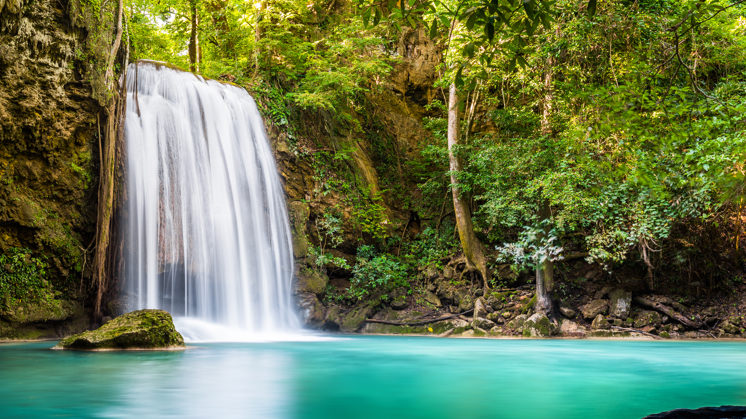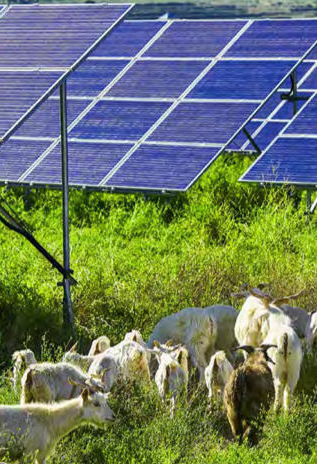Occupation of protected areas
Itemised by facility and types of space
Climate action Nature Biodiversity Renewable energy
The areas where Iberdrola operates are also home to numerous wild animals and plants, some of which are officially protected.

Knowing in which protected areas and places rich in biodiversity the Group operates is key to correct managements of its activities, analysing their potential impact to adopt mitigation measures or implement restoration and conservation projects.
Iberdrola's commitment to the protection and conservation of these areas follows the principles set out in its Biodiversity Policy, through its environmental management systems, action plans and monitoring of habitats restored and/or compensated following the positive conservation management principle.
 Spain
Spain
The presence of reservoirs in protected spaces is 58 % of the total space occupied by reservoirs. Within biosphere reserves, national parks, Ramsar wetlands and natural parks, these reservoirs take up 0.6 % of the surface area of these protected areas.
The Cofrentes Nuclear Plant is located within the Natura 2000 Network. The protected areas are the SCI: Muela de Cortés and the Caroig, and the SPA: Sierra de Martés - Muela de Cortés.
16 % of our wind farms are located in protected natural areas or Special Protection Areas for Birds.
 List of facilities and location in relation to protected areas or areas of high biodiversity value [PDF] External link, opens in new window.
List of facilities and location in relation to protected areas or areas of high biodiversity value [PDF] External link, opens in new window.
 Reservoirs in protected spaces [PDF] External link, opens in new window.
Reservoirs in protected spaces [PDF] External link, opens in new window.
 United Kingdom
United Kingdom
ScottishPower does not have onshore wind farms in protected areas.
ScottishPower Renewables operates some of its 25 wind farms on the fens; a habitat included in the United Kingdom Biodiversity Action Plan for priority species and in Annex 1 of the European Union habitats directive.
The Lynemouth wind farm in England is also in an area with rich biodiversity, due to its importance as a winter haven for swans and geese.
In Ireland, the Barnesmore wind farm is on the Barnesmore Bog Natural Heritage Site (CNS).
ScottishPower Renewables has committed to restoring 9,225 ha of fens in all wind farms, by implementing Habitat Management Plans (HMP). In addition, more than 2,300 ha of forests are managed in 18 parks, of which 833 ha are native forests.
The East Anglia ONE offshore wind farm is in a special South North Sea Special Conservation Area (SNS SAC). Approximately 200 km2 of the East Anglia One project lie within the southern part of the SNS SAC (winter component) designated to protect porpoises, which accounts for 0.5 % of the total area designated for the SNS SAC. The area was formally designated in 2019 after the construction of East Anglia ONE began in 2018. The export cable corridor, the East Anglia ONE Offshore Wind Farm, crosses the Outer Thames Estuary Special Protected Area (SPA) which supports a winter population of red throat divers, which is sensitive to disturbance and displacement from the boat. The export cable corridor crosses the Bawdsey Cliffs SSSI, which is of great geological interest and has potential for studies of Pleistocene non-glacial environments. The SSSI is by far the largest site for Red Crag and is rich in marine molluscs.
 List of facilities and location in relation to protected areas [PDF] External link, opens in new window.
List of facilities and location in relation to protected areas [PDF] External link, opens in new window.
 USA
USA
Only one of the 69 onshore wind farms (1,5 %) is located within a protected area with high biodiversity. This is the Deerfield Wind Project, which covers approximately 32 hectares within the Green Mountain National Forest in Bennington County, Vermont. Deerfield was the first wind project to be authorised and built on National Forest land. The main authorising agency is the National Forest Service.
A total of 481 km of transmission lines (3.5 %) and 2 substations lie within protected areas with high biodiversity. These areas include New York State's Adirondack Park and Forest Reserve, New York State's Catskill Park and Forest Reserve, Letchwork Park, the United Nations' Champlain-Adirondack Biosphere Reserve, and Connecticut West Rock State Park.
Avangrid Networks also operates and maintains nine hydroelectric projects, two of which are located within New York State's Adirondack Park.
| Facility | Location with respect to the protected area | Affected Surface/Length | Degree of protection(1) | |
|---|---|---|---|---|
| Spain | ||||
| Hydroelectric power plants - Reservoirs | Inside | 31,505 ha | Biosphere reserves, Ramsar Wetlands, Natura 2000 Network, national parks and natural parks. | |
| Power lines | Inside | 19,315 km | Natura 2000 network, Ramsar Wetlands, National Park, Nature Park, Biosphere Reserves | |
| Substations | Inside | 131 units | Natura 2000 network, Ramsar Wetlands, National Park, Nature Park, Biosphere Reserves | |
| Transformer stations | Inside | 8,425 units | Natura 2000 network, Ramsar Wetlands, National Park, Nature Park, Biosphere Reserves | |
| Onshore wind farms | Inside | 568 ha | Natura 2000 network, nature areas and important areas for birds and diversity | |
| Nuclear power plants | Inside | 82 ha | Natura 2000 network | |
| Adjacent | 3 units | Natura 2000 network | ||
| Thermal power plants | Adjacent | 6 units | Natura 2000 network, protected landscapes, biosphere reserves and protected marine areas | |
| United Kingdom | ||||
| Power lines | Inside | 3,090 km | National Park, Natura 2000 network, Ramsar Wetlands, National Nature Reserve (NNR) | |
| Substations | Inside | 419 units | National Park, National scenic areas (NSA), Natura 2000 network, Ramsar Wetlands, National Nature Reserve (NNR) and Space of special scientific interest (SSSI) | |
| Transformer stations | Inside | 8,689 units | National Park, National scenic areas (NSA), Natura 2000 network, Ramsar Wetladns, National Nature Reserve (NNR) and Space of special scientific Interest (SSSI) | |
| Offshore wind farms | Inside | 36,700 ha | Natura 2000 network and Protected marine áreas (MCZ) | |
| Onshore wind farms | Partially inside | 10,001 ha | Space of special scientific interest(SSSI) and Priority Habitat from Annex, Habitats Directive (92/43/CEE) | |
| United States | ||||
| Onshore wind farms | Inside | 32 ha | National Forest Systems | |
| Power lines | Inside | 481.1 Km | National Forest (USFS), Nature Preserve, State Forest Reserve, State Conservation Area, National Wildlife Refuge, State Forest, Wildlife Sanctuary, National Trail (NPS), National Scenic Byway. | |
| Brazil | ||||
| Power lines | Inside | 74,774 Km | Areas of environmental protection | |
| Substations | Inside | 130 units | Areas of environmental protection | |
| Transformer stations | Inside | 85,874 units | Areas of environmental protection | |
| Hydroelectric power plants | Inside | 4,813 ha | Important Bird and Biodiversity Areas (IBAs), High-Biodiversity Wilderness Areas (HBWAs), UNESCO-declared Biosphere Reserves, Key Biodiversity Areas (KBAs), Private Nature Park Reserves (RPPNs) - Brazil | |
| Adjacent | 1 unit | UNESCO-declared Biosphere Reserves, Nationals Parks, Natural Monument, -Brazil, National Park (Pama) | ||
| Wind Farm | Inside | 8.32 ha | Key Biodiversity areas (KBA) | |
| Adjacent | 1 farm | Key Biodiversity areas (KBA), Areas of environmental Protection (APA) | ||
| Greece | ||||
| Wind farms and photovoltaic plants | Inside | 161 ha | Natura 2000 network and Important Biodiversity Area (IBA) | |
| Hungary | ||||
| Wind farms |
|
3 wind farms | Close to areas of the Natura 2000 network and Ramsar Wetlands | |
| Portugal | ||||
| Wind farms | Inside | 0.09 ha | Natural reserve | |
| Romania, Germany and France | ||||
| None | ||||
| Cyprus | ||||
| Onshore wind farms | Inside | 0.18 ha | Natura 2000 network | |
SPA: Special Protection Area for Birds, according to the EC Birds Directive.
SCI: Site of Community Importance, according to the EC Habitats Directive.
SAC: Special Area of Conservation, according to the EC Habitats Directive.
Ramsar: Wetlands of international importance, according to the Convention signed in Ramsar.
SSSI: Site of special scientific interest (UK designation).
NSA: National scenic areas (UK).
NNR: National nature reserve (UK).
Iberdrola identifies endangered species included in the UICN Red List and the national and regional lists for the areas in which it operates through its environmental management systems and/or observation programs.

Biodiversity protection
How do we protect and preserve biodiversity on some of our more flagship projects?

SDG 14: Life below water
Our offshore wind business is respectful of the marine environment.

SDG 15: Life on land
Protecting and promoting the sustainable use of terrestrial ecosystems.




